The McLaren Artura Is a New-School Hybrid and an Old-School Supercar

Ripping around Spain with a sun-baked British tourist, the McLaren Artura, checks off a familiar checklist for McLaren fans: A feathery carbon-fiber architecture and curb weight of just 3,303 pounds. A count-of-three to 60 mph, and 205-mph top speed. Feelsome electro-hydraulic steering, and brakes more sensitive than a Berkeley gender-studies major.
Yet plugging away in the 671-horsepower, V-6 Artura, the brand’s first series production hybrid, reveals more than the expected rush of fluid performance. As it embarks on a second decade of street-going machines, McLaren has delivered one that feels like a complete sports car, from more-cohesive design to an interior that jettisons Garmin-grade tomfoolery or haphazard touch points. This racing-obsessed Brit is growing up, growing into its role as leading foil to Ferrari or Lamborghini. That means taking care of little things that still matter to people who spend $200,000-and-up on cars: Competitive luxury, infotainment and driver-assistance systems. A robust warranty and customer service. For the Artura, daily drivability, even if many owners are fine with weekend assignations and a stable of other cars. For all the groundwork it has laid over an opening decade — including moments of true technical leadership — McLaren Automotive remains an underdog to a legend-pushing Ferrari and VW-backed Lamborghini, and needs to try harder. Especially for a company that, unlike every peer, refuses to take the easy route to customers with an SUV.

What underdog McLaren can’t afford is to see its reputation for innovation and performance sullied by product delays or electronic glitches – and one pesky vehicle fire -- such as those experienced by some journalists at the Artura launch. (More on that later.)
McLaren’s signature steering wheel underscores the brand’s clarity of purpose. Its unusually slim section width is the ideal interface for sensation-starved fingers, via hydraulic-assisted steering that weights up beautifully in corners; then goes light when the Artura finally loses grip on glorious Spanish pavement. Confident drivers can engage Variable Drift Control through the Artura’s newly straightforward, tablet-style infotainment screen, to allow up to 15 degrees of yaw before ESC intervenes. Refreshingly, there’s not a single redundant control on that steering wheel, flanked by metal paddle shifters. With a pair of analog rockers, the column’s integrated instrument binnacle lets drivers adjust powertrain and suspension settings without taking hands off the wheel. Column stalks manage a new high-definition driver’s cluster and new stop-and-go adaptive cruise control.
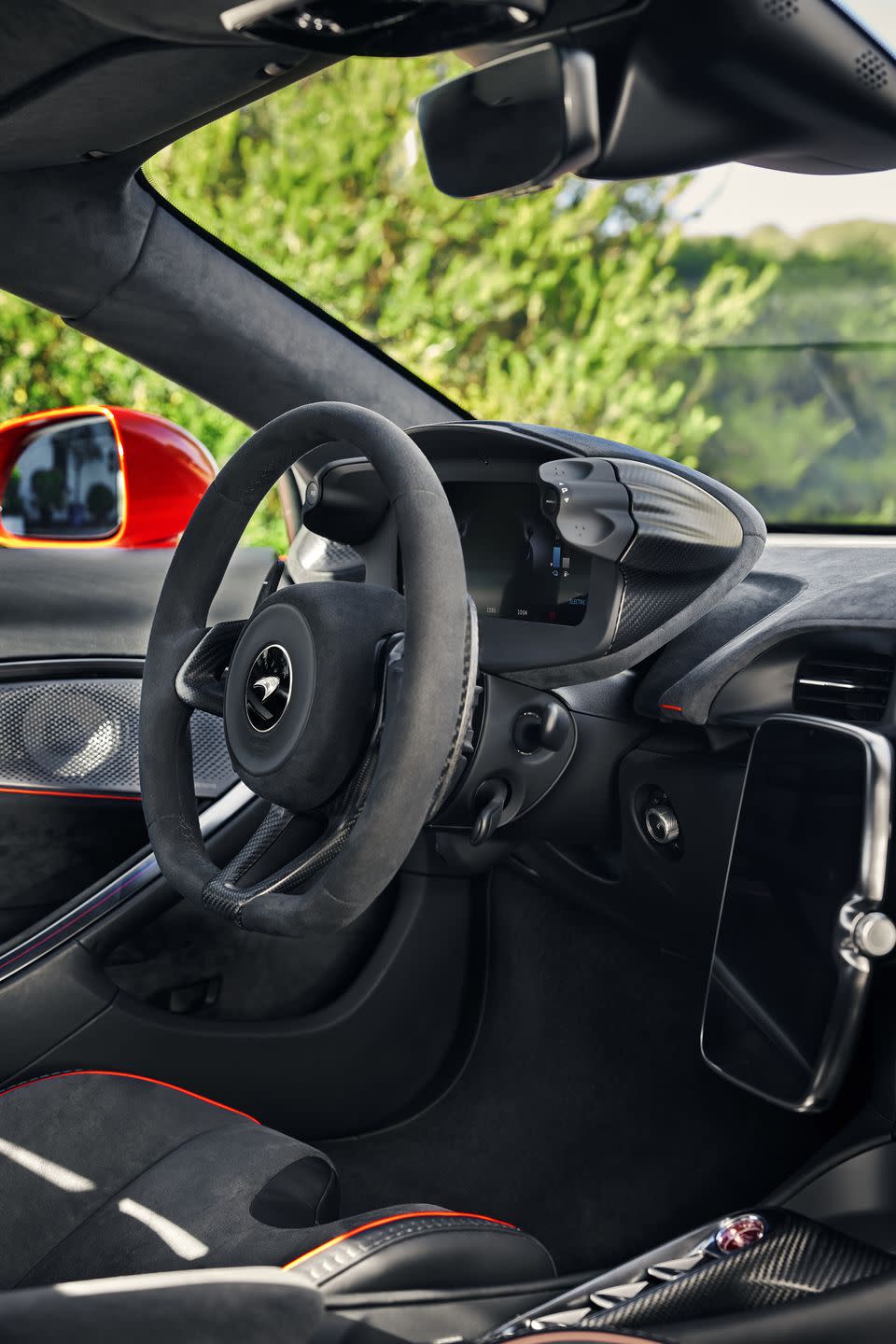
An opening Artura run shoots us from the Mediterranean sun and sea of Marbella, to the Ascari circuit, a gated playground of 3.37 miles, 26 turns and a freshly repaved surface. Spain itself is pretty much one big auto amusement park. Today, its austere, painterly landscapes are filled with blurry brushstrokes from our fast-moving Arturas, in exploding Fauves colors such as Volcano Orange and new Flux Green. The latter’s yellow-green hue recalls the skin of a worrisomely poisonous Amazonian frog. In other words, perfect for a McLaren.
Small-scale potency continues with a 3.0-liter V-6 that brings 577 horsepower all by its downsized self, and a racy 8,000-rpm redline. Compared to McLaren’s V-8’s, the “M630” V-6 is 7.5- inches shorter, 8.7 narrower, and 110 pounds lighter, adding just 352 pounds at the Artura’s midsection. Twin “hot vee'' turbochargers reside in the engine’s 120-degree cleavage. Superheated air escapes through a black “power chimney” atop the rear deck, reducing it from 900 degrees Celsius to 240 degrees.

577 horses is a boggling output for a 3.0-liter V-6, but still won’t cut it in supercar country. So an axial flux electric motor, integrated in the transmission bell housing, serves up 94 additional horses, for a total of 671. At 34 pounds, the Artura motor weighs half that of the groundbreaking McLaren P1 hybrid’s, yet is 33-percent more energy efficient on a per-pound basis. A 7.4 kilowatt-hour battery feeds the motor, with a 2.5- hour charge (at Level 2 rates) boosting it to 80-percent full. Its lavish “torque infill” of up to 166 pound-feet, concentrated in the 2,000-to-5,000 rpm range, ably fills any chinks in the V-6’s armor. Compared with McLaren’s sometimes-laggy turbo V-8’s, the Artura’s immediate throttle response is welcome. Forget the cylinder shortage: This McLaren is wickedly fast, as a pair of skilled sport bikers learn when we team up for a blistering run through the countryside. I humor the thumbs-flashing bikers and pace them through curves at whatever speed they dare. Then the Artura blasts ahead, ridiculously, waits for them to catch up, and does it all over again.
If the velocity is dramatic, the sound is less so. The V-6 purrs at idle and shows real claws as it climbs to a thrilling 8,000-rpm treetop. Its sound is rich and pleasing, yet pillowed, in part by those Hot Vee turbos. Even on a short list of tuneful V-6’s, the McLaren can’t touch the bravura howl of Ferrari’s own 3.0-liter in the 296 GTB Hybrid, the “piccolo V-12” whose frequencies and firing order mimic those of a Ferrari V-12.
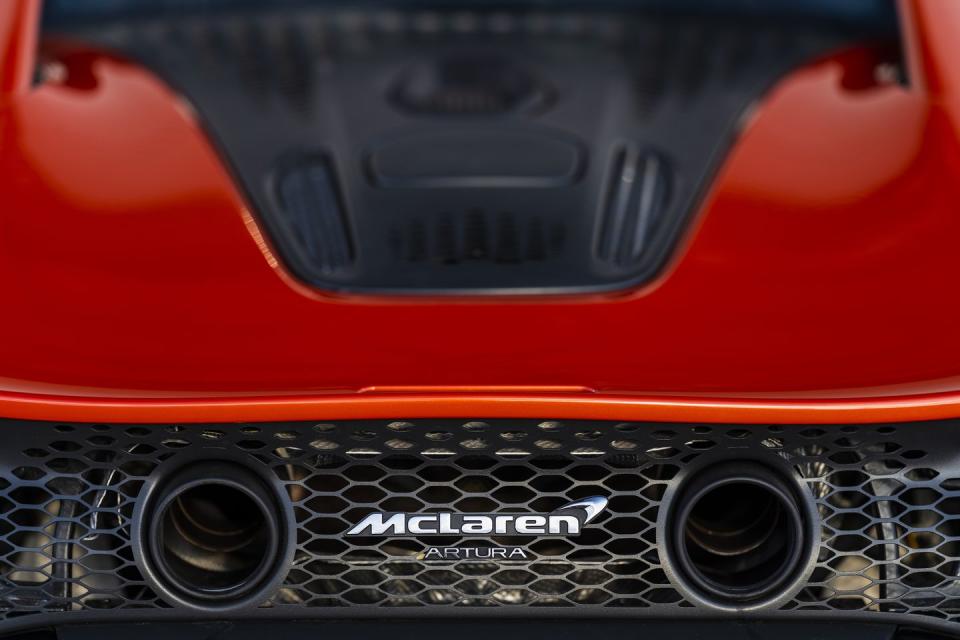
To heighten the Artura’s quicksilver moves, McLaren engineers met an ambitious target: To entirely offset 287 pounds of hybrid hardware (including a 194-pound battery) with weight reductions elsewhere. Designed for hybrid applications, the McLaren Carbon Lightweight Architecture (MCLA) assembles some 500 pieces of fiber cloth into 72 preformed shapes. The monocoque is so light, at 180 pounds, that even a pair of auto journos easily hoist it off a paddock stand. MCLA weighs virtually the same as McLaren’s previous architecture. But that’s not apples-to-apples, because MCLA renders many more components in carbon fiber, including a crash-resistant battery compartment and door-hinge mounts. A rear clamshell deck is another point of engineering pride. It’s superformed into a single, 33-pound aluminum artwork, with leftover metal from manufacture reused elsewhere in the car. A new Ethernet electrical architecture cuts cabling by 25 percent. A stiffer multi-link rear suspension and aluminum structures trim weight and boost control. McLaren’s first-ever electronic rear differential shuttles power side-to-side.
More Macca cleverness, with an attendant patent filing: There’s no reverse gear, saving the weight and space of an extra cog. The E-motor simply spins in the opposite direction to create reverse drive. McLaren also adds one speed to its dual-clutch automated gearbox, for eight forward gears. Add up the savings, and the 3,303-pound Artura undercuts a 720S by 164 pounds; though it weighs nearly 100 more than a 570S, the model it essentially replaces. The Artura defaults to emissions-free EV operation on push-button start-up, and can cover about 11 miles on electricity alone at up to 81 mph. In summer traffic in oceanside Marbella, it’s cool to whisk the Artura along on silent EV power, despite mellow acceleration. Switch the powertrain to Comfort mode, and the prod of a right foot awakens the engine via a clutch.

Sport and Track settings run the V-6 at all times, and divert engine power under light (or no) throttle to replenish the battery. Which brings us to standard carbon-ceramic brakes. They’re as purist-leaning as the steering, eschewing not only the by-wire braking of models like the 296 GTB, but any electric regeneration. Recuperation is managed exclusively through the electric motor, which can harvest up to 24 kilowatts. So unlike the Ferrari, the Artura leaves some potential efficiency on the table, ostensibly in the interest of better brake-pedal feel. Track mode best sustains battery charge, to ensure full-bore performance even in extended track use. McLaren engineers say the Artura can run 40 consecutive test laps at Italy’s ultra-taxing Nardo circuit with no degradation of electric assist. On the street, or for track days, you should be OK.
On the same philosophical page as the Ferrari 296 GTB, McLaren shortened the Artura’s wheelbase to 104 inches to boost agility and feel, roughly splitting the difference between the Ferrari’s 102.4 inches and the 105.1 inches of McLaren’s 570 or 720. Yes, Ferrari’s own plug-in, 3.0-liter hybrid is even stronger and faster, squeezing 818 horses from a same-sized V-6 and single electric motor. The 296 GTB clips 124 mph (200 kph) in a nut-job 7.3 seconds, versus 8.3 seconds for the Artura. The Artura shouldn’t feel bad: The V-6 Ferrari matches a Porsche 918 Spyder to 124 mph, and out-accelerates most V-8, V-10 or V-12 supercars, including its F8 Tributo and 488 Pista cousins, any Lamborghini Aventador, or a 720S, which takes about 7.6 seconds to reach 124 mph.
Setting aside (for now) comparisons with the much-pricier Ferrari, the McLaren is its own delight: Supple, poised, playful at the limits of adhesion. And acceleration isn’t exactly stingy. If a 3.0-second launch to 60 mph, a 10.7-second quarter-mile, and 205-mph peak isn’t enough, perhaps consider methanol drag racing as your new hobby. The Artura does feel less vivid and wound-up than a 720S or even 570S. It’s a more subtle, well-rounded proposition, still oodles of fun. That includes outstanding ride quality, the Artura’s Comfort-mode dampers soothing nasty city roundabouts.
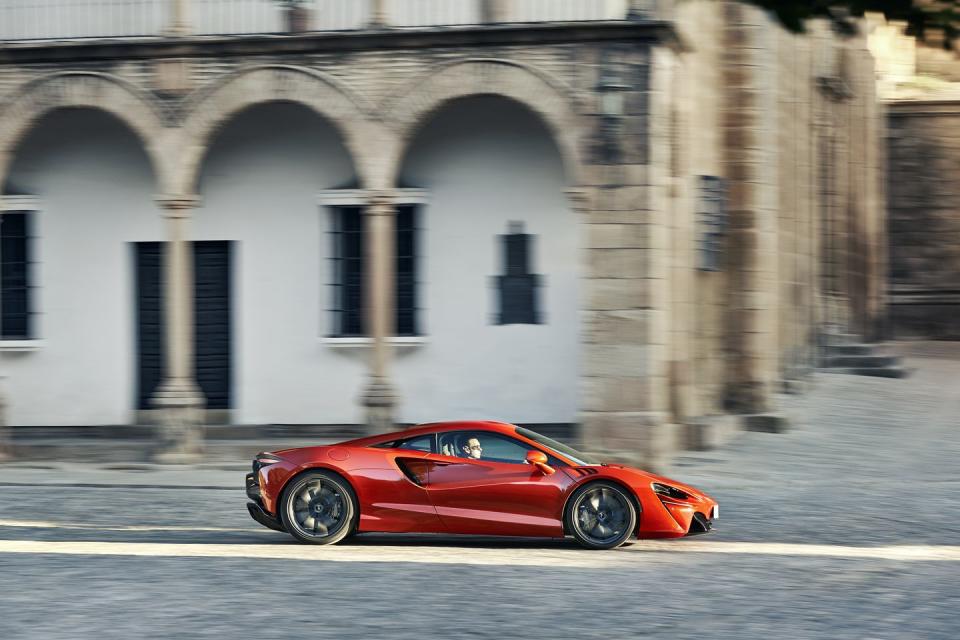
The only troubling bit was a series of electronic gremlins that affected several Arturas, though none on the U.S. media wave we attended. Some Arturas had their UI screen conk out, failed to recognize onboard smart keys, or sent an erroneous fault message. McLaren had cautioned us that the Artura’s software wasn’t finalized for customer cars that begin delivery in July, though this may sound both worrying and familiar. Software (and chip) issues were the culprit in the postponement of the Artura’s planned media introduction last fall.
“It’s a bit unfortunate that after so much time off, we’re still dealing with software,” McLaren spokesperson Laura Conrad said. “But we do know we have one more software drop to go.”
On a previous wave of U.K. journalists, an Artura briefly caught fire on track. McLaren said a supplier’s fuel-pipe nut had been torqued incorrectly, a one-off issue that was quickly identified and corrected. In fairness and context, all kinds of cars smoke or flame on track — including some of the best and winningest cars in history — often due to a single faulty part, a wrenching oversight or rotten luck. It isn’t necessarily an indictment of a particular car’s design or construction philosophy. But here’s a good time to mention McLaren’s new, comprehensive five-year warranty (six on the hybrid battery), which buyers can extend to as long as 15 years, and transfer to a new owner.
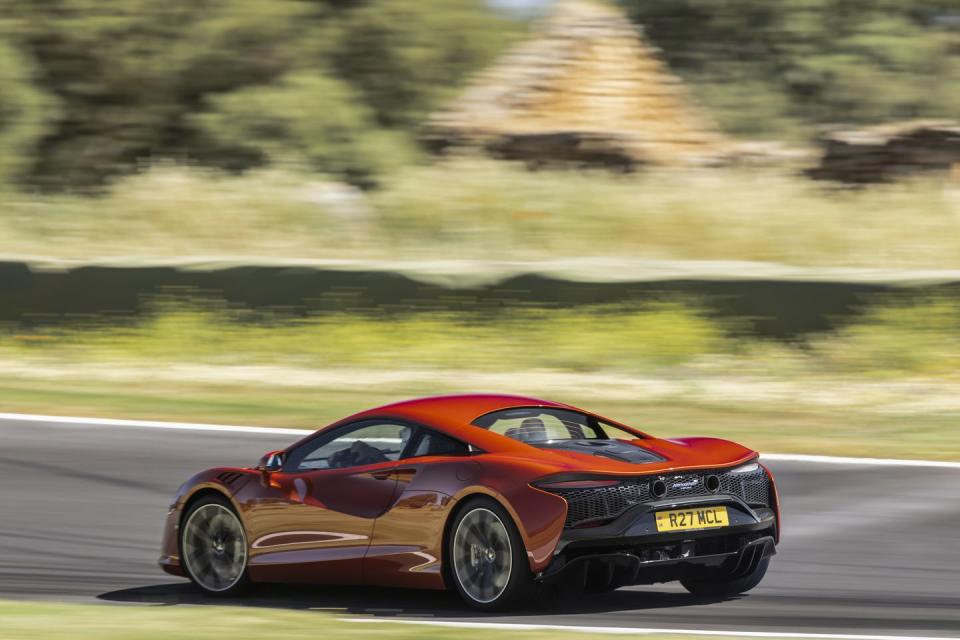
In pit repose, we walk a lap around the Artura. Redesigned dihedral doors describe a narrower arc while opening, for less nervousness in tight parking spaces. The Arturo’s cab-forward, high-tail design still declares McLaren’s function-first ethos. But compared with some predecessors, the visual forms really cohere, including sharp flying buttresses that curl into the rear deck. Cavernous side intake cavities play nicely with the body sides and front openings. Functional details appear more determined and stylish, including front fender louvers to relieve pressure and clean air flow. McLaren has steadily found its personal style, and can flaunt it with confidence.
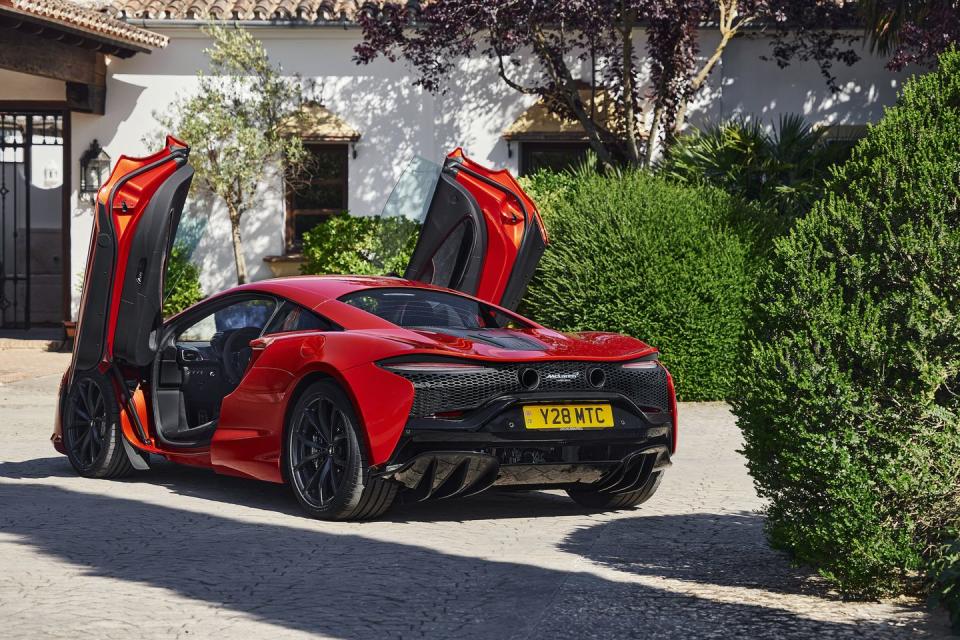
Compared with a deeper-pocketed Ferrari, or a Lamborghini that benefits from a parts-bin sugar daddy in Audi and VW, McLaren’s interiors have been a sore spot in luxury and tech. The Artura’s cabin remains no-nonsense, but no longer comes off as clinical, or badly trailing the tech curve. Just a few years ago, asking a McLaren navigation system — including the notoriously balky, maddening “Iris” units — to guide us to Ascari would have left us in Andorra. As noted, the new MIS II nav and infotainment worked fine during our media wave. A redesigned HVAC system adopts handsome new dash vents with metal sliders; a full-width secondary panel now diffuses air to avoid direct blasts on your hands or face. A low-energy Bluetooth key fires up onboard systems upon driver approach. Apple CarPlay and Android Auto are new to McLaren. The Artura’s door sills are also slimmer and lower, so you feel less like a Cirque du Soleil clown while climbing in or out. That ingress finds a new, weight-saving Clubsport seat, with a Comfort seat available. Instead of the one-note fixed backrest of a racing bucket, the Clubsport chair pivots to adjust backrest, under-thigh support and seat height along a single elliptical arc.
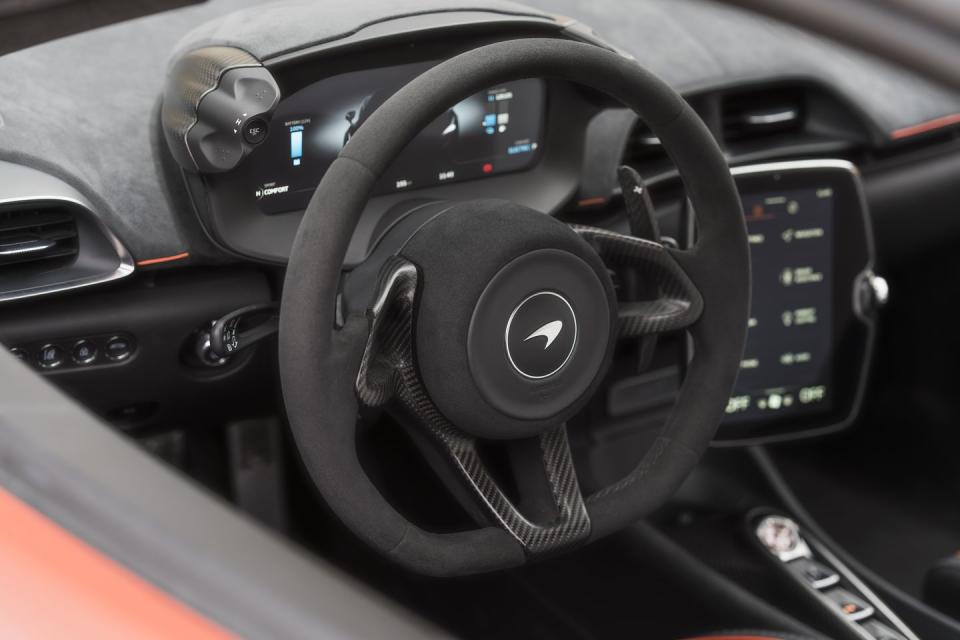
McLaren executives and engineers played down any competitive streak versus the Ferrari, which happens to start from $323,000, nearly 100 grand more than the Artura at $237,500. The McLaren’s direct competition, executives insist, is sub-$250,000 players such as the Lamborghini Huracan Evo and Maserati MC20. I can picture a 911 Turbo S fan seeing the Artura as a more visually exciting, exclusive addition to a six-cylinder garage, for a defensible upcharge. From a hybrid perspective, picture the Artura as a better Acura NSX, in everything from design and performance to brand cachet. And the NSX is a damn fine sports car to drive. Either way, get used to more hybrid wonders like the Artura, 296 GTB and NSX. Even the world’s supercar leaders are realizing they can’t compete without harnessing electricity, not only to keep pace with regulations, but with rivals.
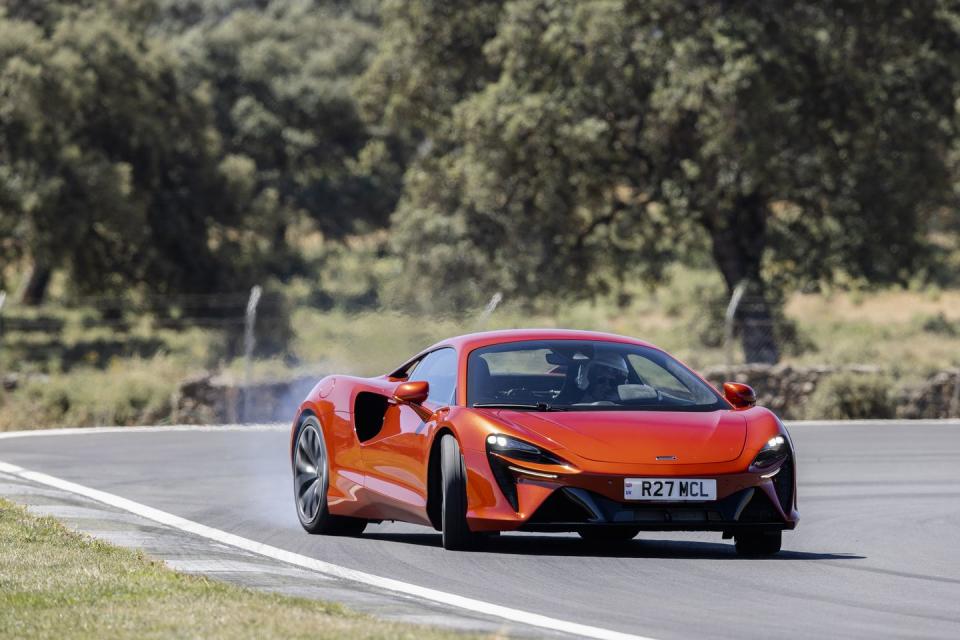
You Might Also Like

 Yahoo Autos
Yahoo Autos 